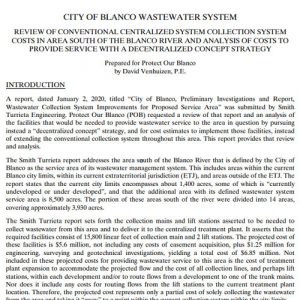Blanco Comparison of Centralized vs. Decentralized Wastewater System Costs

A report, dated January 2, 2020, titled “City of Blanco, Preliminary Investigations and Report,
Wastewater Collection System Improvements for Proposed Service Area” was submitted by Smith Turrieta Engineering. Protect Our Blanco (POB) requested a review of that report and an analysis of the facilities that would be needed to provide wastewater service to the area in question by pursuing instead a “decentralized concept” strategy, and for cost estimates to implement those facilities, instead of extending the conventional collection system throughout this area. This report provides that review and analysis.
The Smith Turrieta report addresses the area south of the Blanco River that is defined by the City of Blanco as the service area of its wastewater management system. This includes areas within the current Blanco city limits, within its current extraterritorial jurisdiction (ETJ), and areas outside of the ETJ. The report states that the current city limits encompasses about 1,400 acres, some of which is “currently undeveloped or under developed”, and that the additional area with its defined wastewater system service area is 8,500 acres. The portion of these areas south of the river were divided into 14 areas, covering approximately 3,930 acres.
The Smith Turrieta report sets forth the collection mains and lift stations asserted to be needed to collect wastewater from this area and to deliver it to the centralized treatment plant. It asserts that the required facilities consist of 15,800 linear feet of collection main and 2 lift stations. The projected cost of these facilities is $5.6 million, not including any costs of easement acquisition, plus $1.25 million for engineering, surveying and geotechnical investigations, yielding a total cost of $6.85 million. Not included in these projected costs for providing wastewater service to this area is the cost of treatment plant expansion to accommodate the projected flow and the cost of all collection lines, and perhaps lift stations, within each development and/or to route flows from a development to one of the trunk mains.
Nor does it include any costs for routing flows from the lift stations to the current treatment plant location. Therefore, the projected cost represents only a partial cost of solely collecting the wastewater from the area and taking it “away” to a point within the current collection system within the city limits.
The report also addresses routing of treated effluent – reclaimed water – from the current treatment plant location to the defined service area for reuse. The facility for this is asserted to be 15,800 linear feet of reclaimed waterline. The projected cost of this line is $1.1 million, with a note that “cost does not include design, survey, geotechnical investigations, easement acquisition or construction cost for pump station/elevated storage”. Therefore, this cost too is a very truncated estimate of the total cost of attaining a reuse benefit from the reclaimed water, as it omits not only the items noted but also any facilities to actually disperse and utilize this water within or around the developments.